In our last post Jennifer explained how our project team came together, and finished by introducing a little box I made for her from the wood we are using for the project:


This is one of a series of boxes that I am slowly working through for the people who are making this project possible. This has become a small secondary project for me, ensuring that everyone has a little keepsake of the materials which inspired us to begin Recycling a Hospital. The project started however from my very practical need to understand exactly what we had to work with, as until I had got to know this wood I couldn’t think about design ideas for the piece we would make for the EFI building.
Communing with wood
Why not just start with a design, and then find the materials to realise it? There is an approach in woodworking that has been a considerable influence on my thinking about the craft. This approach holds that the wood itself should be an active partner in the design of any artefacts crafted from it.
One of the key proponents of this approach was the late James Krenov, who in his 1979 book ‘The Impractical Cabinetmaker’ critiqued a common designer-led approach to designing original pieces of furniture, saying that:
“The fundamental fault of such an approach, which urges us to start with “originality,” is that trying to adapt the idea to wood will cause the idea to isolate itself. In a sense, it will be too strong for the wood, because its demands on the wood cannot be met without a misuse of wood.”
To avoid such misuse and, in his opinion, arrive at better designs, he argued that any design is best accomplished in partnership with the material, the wood, from which it is built, and that the interactions with the wood of the maker’s hands and tools are as important as their eyes and imaginations.
In our case, with Recycling a Hospital, it is very important that the materials salvaged from the building take centre stage and are not misused. Indeed it is the very uniqueness of the materials, and the stories to which they have contributed, and carry with them, that are the spirit of the project. Krenov’s contemporary George Nakashima wrote in his 1981 book ‘The Soul of a Tree’ that:
“The tree’s fate rests with the woodworker. In hundreds of years its lively juices have nurtured its unique substance. A graining, a subtle coloring, an aura, a presence will exist this once, never to reappear. It is to catch this moment, to identify with this presence, to find this fleeting relationship, to capture its spirit, which challenges the woodworker.”
It is this spirit—of the wood, the slate, the stone and the poetry of the building—that we aspire to carry through into its new incarnation as the EFI building. Therefore, before beginning to design our piece, I had to first commune with the spirit of the wood we would be working with.
Introducing the pine
In the Spring of 2022 I had the opportunity to visit the building site with our EFI colleague Ingrid Heersche, the Senior Project Manager of the redevelopment. She had important work to do with the construction and conservation teams working in the building, but for me it was a scavenger hunt, looking for materials that were being taken out of the building but would not be able to go back in—unless we could turn them into art. Over the course of an afternoon on the building site I accumulated an armful of different materials, including bricks, tiles, iron sash window weights and window frames. The materials which most drew my attention however, were the roof slates…
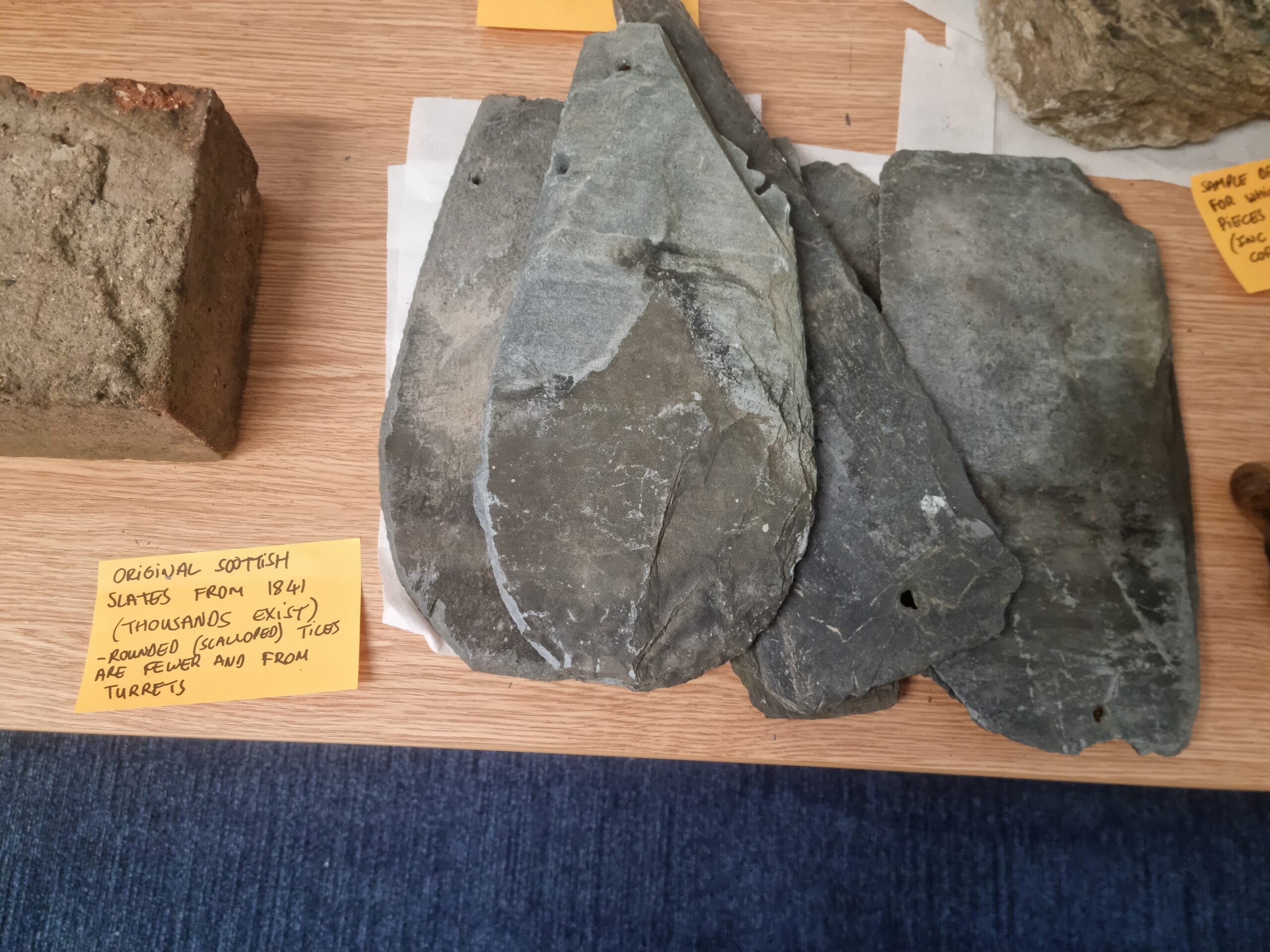
…and, as a woodworker, six pine floor beams, the snipped off ends of a couple of which I took from the building site to the temporary offices of the EFI.
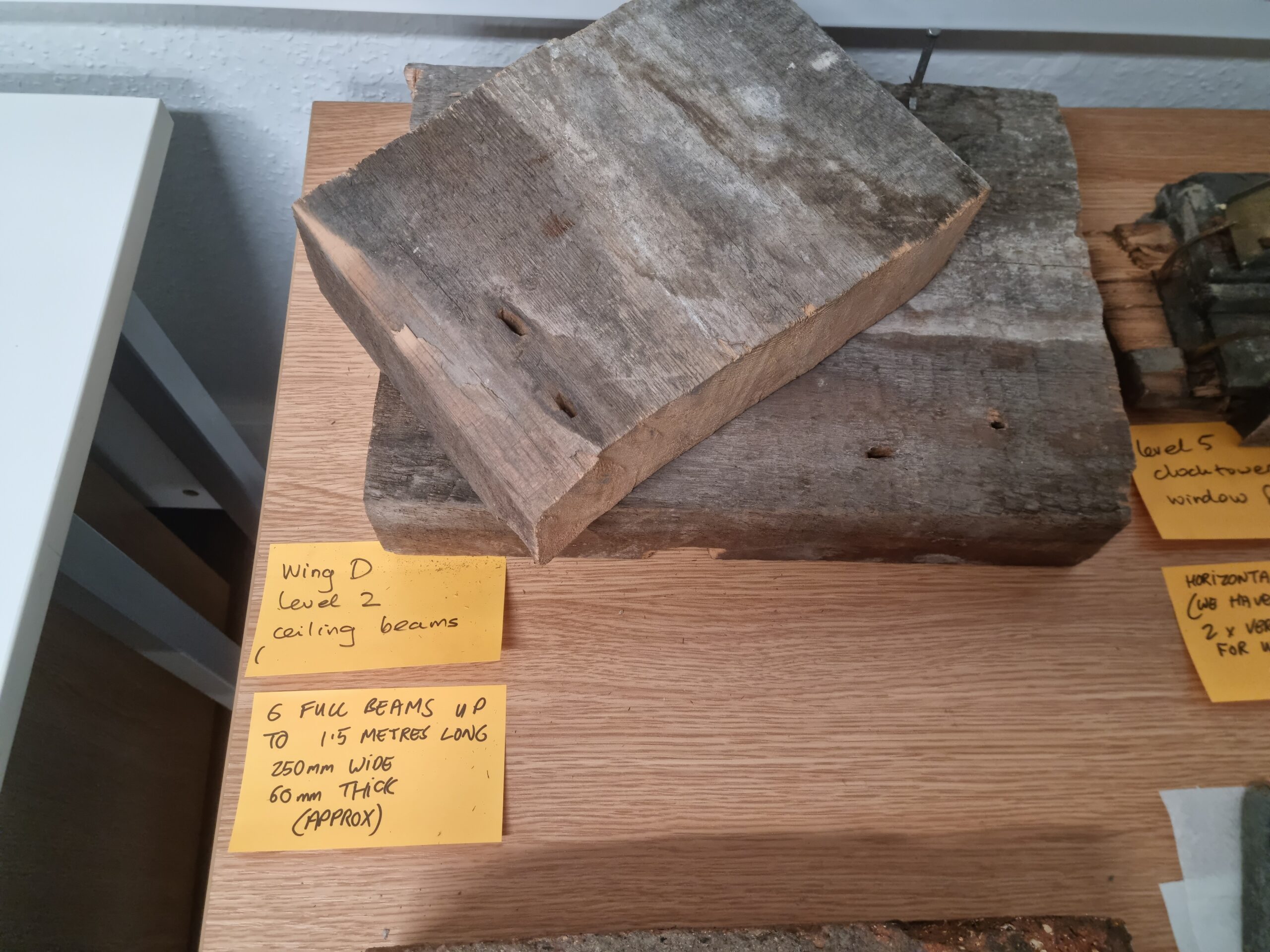
The conservation expert with us that day thought that both of these materials had very likely been in or on the building since it was first constructed in the 1870s (and not, as I mistakenly noted in the image of the slates above, in 1841). They had been part of the building since the very beginning, and I desperately wanted them to continue to be a part of it into the future. As Jennifer noted in her previous post, there is great symbolism in their functions as supporters from below and protectors from above, and over the next few months I thought about possible uses for them.
I came up with various different designs for a piece which would bring together the pine and the slate, but none really worked for me. By the time that the funding for the project had been confirmed in early 2023 I realised that in order to come up with a satisfactory design I would need to commune with the pine much more deeply, I would need to get to know it with my hands and not just my eyes.
Making a box
The beam ends that I had to work with had been buried within the structure of the hospital for 150 years and had seldom, if ever, seen the light of day since the day they were installed. As hidden parts of the structure no effort at the time had been dedicated to making them pretty. The surfaces were rough and uneven and had developed a grey patina over the decades. They were also full of nails, which I had to remove first lest they ruin the hand plane blades and chisels that I would go on to use in my home workshop (which doubles as my living room).

Once confident that no metal remained I went through the process which is familiar to any woodworker of methodically preparing the stock. I planed one face and checked that it was flat and true…

…and then I planed an edge to be perpendicular at 90˚ to it…

…before working from these reference faces until I had two flat and parallel faces and two flat and parallel edges.
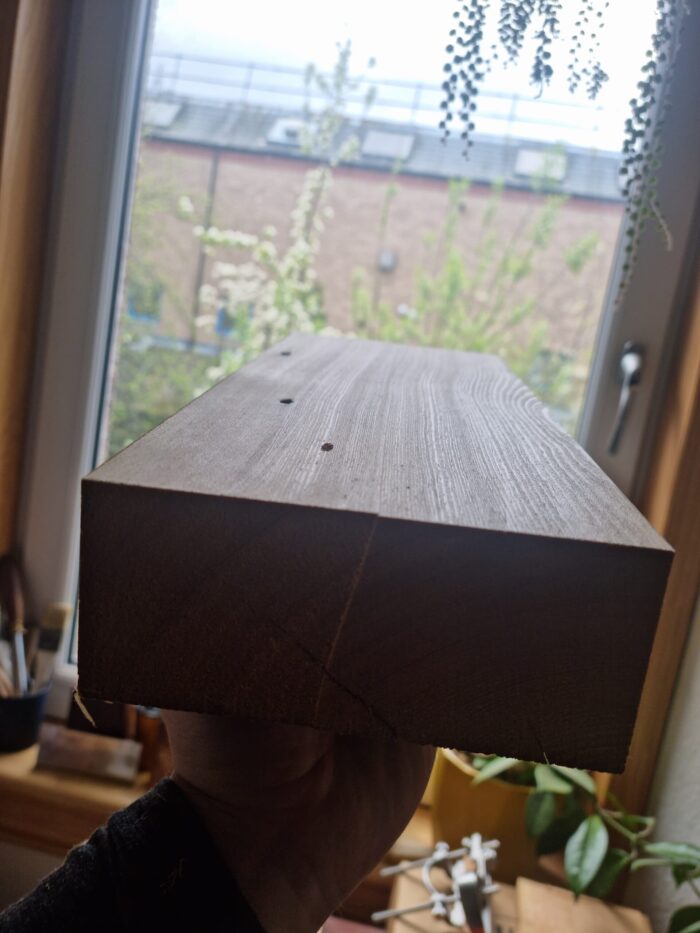
I was then able to use my saw to break down the large block into the smaller pieces I would need for what I had by then determined would be the first of a series of small boxes.
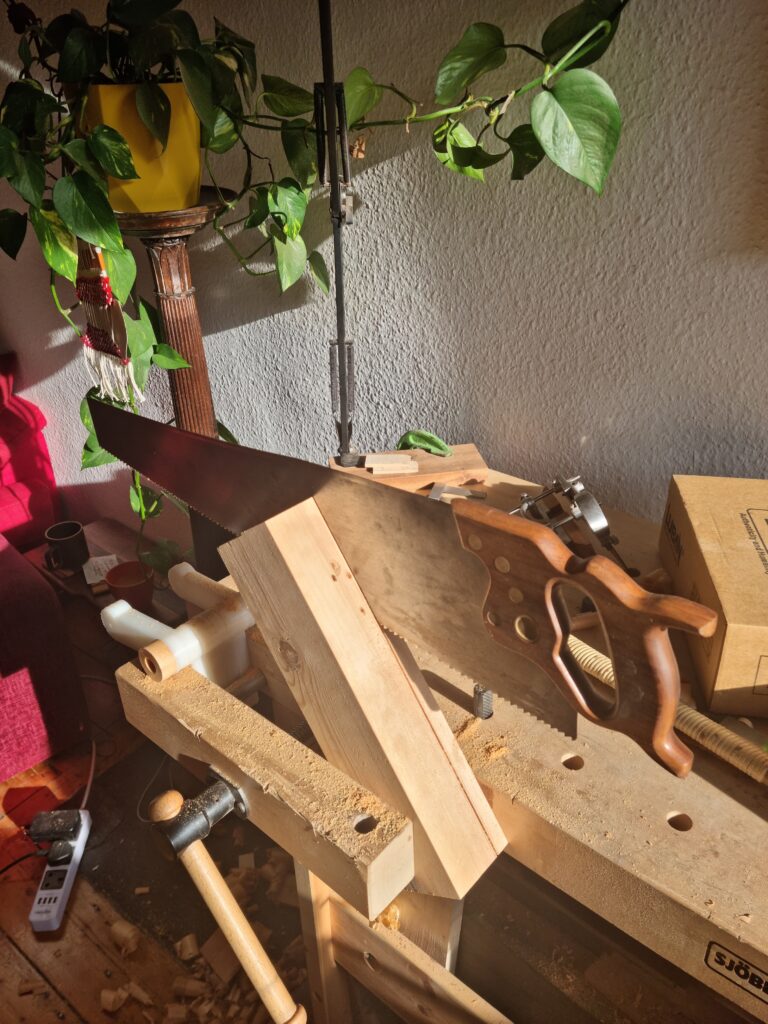
I didn’t have high hopes for the quality of the wood at the beginning, so rough and unlovely it was, but the idea from the outset was to work with the material we had, regardless of its ‘quality’. However, whilst there were large and awkward knots and many nail holes to work around I was blown away by the beauty of some of the tight grained antique pine I found within.

The design
From this beautiful recycled pine I went on to make the box that is pictured at the beginning of this post, and it was in this making process that the process of designing our project artwork really began. Working with the pine in the making of the box I also worked with it in developing the initial design concept. This is not to say that the design of the box bears much similarity to the design of the project artwork, but rather that in the process of developing an understanding of this pine it led me to a design.
This design concept was then shared with the human members of the project team and, after discussion and inputs from all, we came to a design of a wooden structure, influenced by James Krenov’s famous cabinets on stands, on which the roof slates will be fixed after Gus Fisher carves into them the poetry developed by Jennifer Williams, nurses who formerly worked in the hospital and members of the local community.
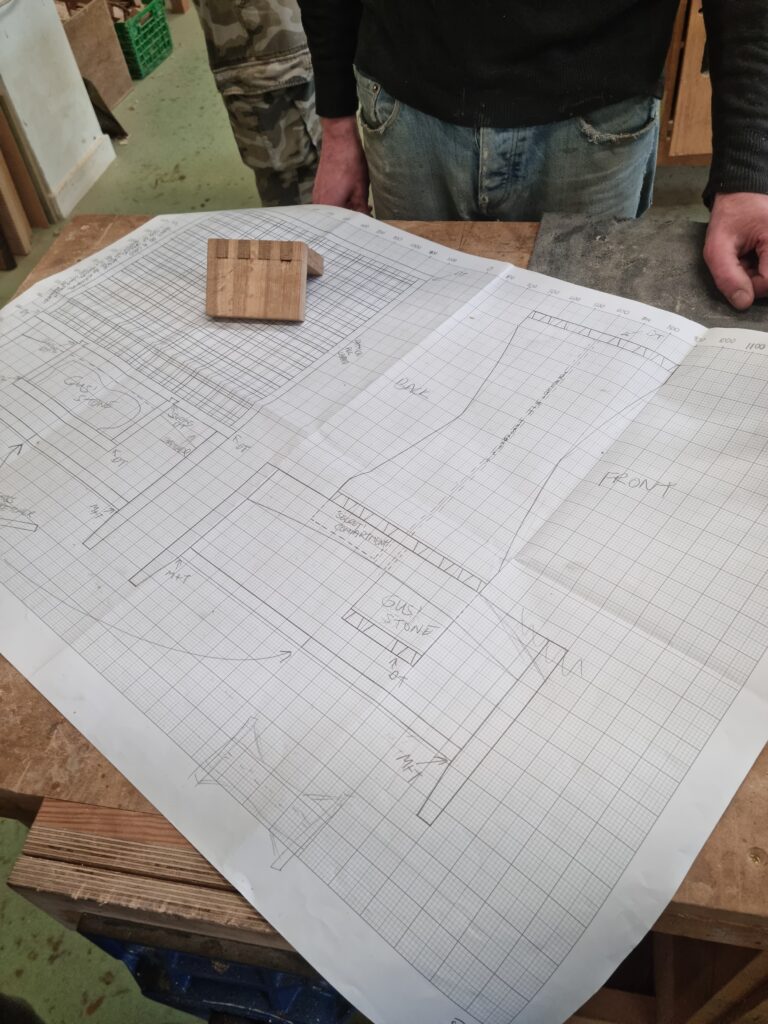
At the time of writing this post I am in my second week of working alongside Jon Slight and his team in the Grassmarket Community Project’s woodworking workshop. We are working to the broad design pictured above, but it is subtly changing in order to accommodate the wood we are working with. In my next post I will pick up this story and introduce more fully the Grassmarket Community Project’s furniture programme.


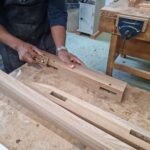
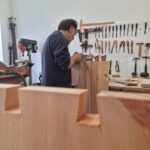




Elizabeth Adamson
13th August 2023 — 12:25 pm
I loved reading this account of handling the wood with safe hands and creating something of simple beauty that would hold treasures from the past.